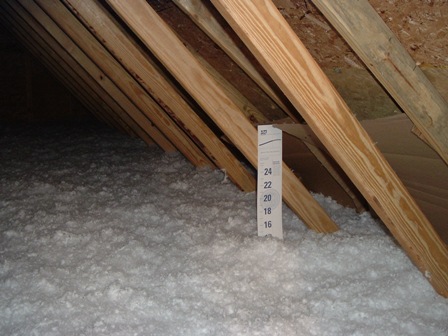
*Latest Positive Pressure HEPA Filter*
I learned a lot from the last positive pressure HEPA filter that we installed in the old shelter (part one, part two). One of the things I learned was that the in-line bilge blower was not durable enough. One of the reasons I choose the bilge blower was because of its low 36 Watt power draw, but I wanted to do better if possible. The other thing I learned that was not obvious in the engineering phase was that condensation in the system became a problem in the summer when it was hot and humid outside. The hot, humid outside air would enter the HEPA filter and get sucked inside the house through the PVC pipe and into the below grade shelter. Since the HEPA filter itself was "outside" and at the same temperature and humidity as the surrounding air it was OK but everything underground was cold and the moisture would condense inside the pipe and end up running out of the blower as water. Not only was this annoying but it offered mold a chance to take hold. Finally, the last blower was way too loud. It made too much noise itself and the vibration was coupled into the plastic piping, which could be heard throughout the house. The new shelter offered an opportunity to improve that situation as well as put in a squirrel cage type centrifugal blower that used less power.

The HEPA filter pipe was run from the shelter in the basement to the attic over the sunroom. I wrote "Future Radon Vent" on the pipe and stuck a matching pipe in the floor of the shelter (uh, "Storeroom") so the county building inspector would stay happy. The top of the pipe is in here somewhere!
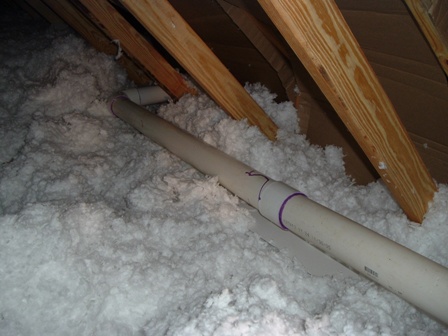
Ok, found the pipe and glued the extension onto it. It's hard to see in this picture, but the entire length of pipe is sloped into the shelter so that any condensate will drain that way. You also need to pay particular attention to the glued joints here; they must be airtight or you'll suck contaminated air into your shelter. Don't be afraid of it; just be careful to make good glue joints.
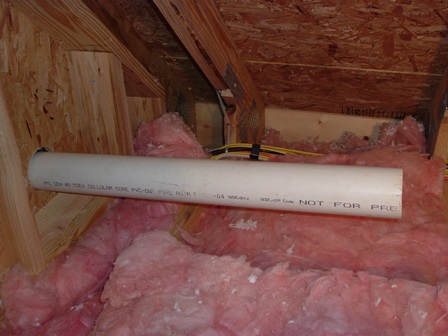
I wanted the actual HEPA filter to be easily accessible so I could check on it and change it out so I extended the pipe into the under the eves portion of the house attic where I could get to it. It's a little easier to see that the pipe is sloped here.
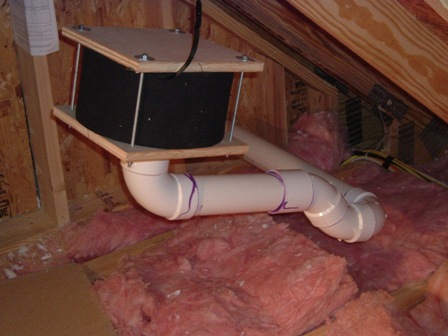
Here's the business end of the HEPA filter. It's a Rubie standard design coupled to the PVC pipe. This one has a carbon pre-filter on it. You can see clearly in this photo that the piping is sloped. The filter is simply hung from a metal strap.
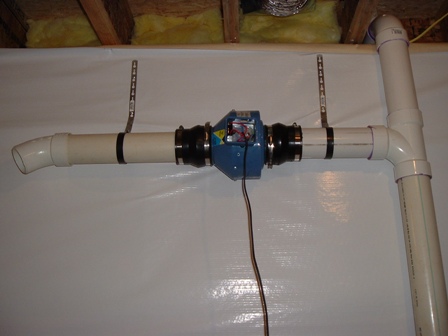
Inside the shelter is the new Fantech FX4 radon blower. This thing is great! Its centrifugal impeller is mounted to a ball bearing motor. Radon blowers are designed to run 24/7/365 and this one's lifetime is a minimum of 5 years continuous operation. It's also super quiet and coupled to the piping with rubber connectors the only thing you can hear is a slight airflow sound right at the HEPA filter. I sealed the rubber connectors to the pipe and blower with 100% silicone RTV. The blower runs on 120VAC so you need a way to make power in an emergency. On the positive side, it only draws 17 Watts as shown on the Kill-A-Watt! It's been tested on both a true sinewave inverter and a modified sinewave inverter; both work fine. While we're on this picture, note the orientation of the "T" connector on the right side; it's designed to direct condensed water into the collection pipe that sticks down.
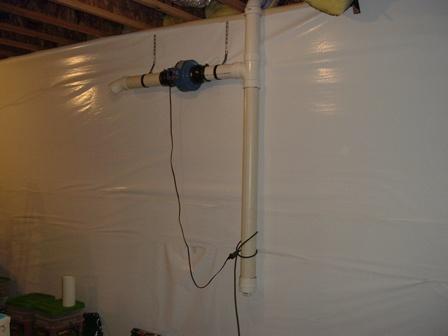
Here's a shot of the whole system, showing the condensate drain. It has a standard threaded plumbing clean out fitting at the bottom. Every so often I put a bucket under the pipe, turn the plug out by hand and drain any collected water. The angled fitting on the top left side is not glued on. I left it loose so that I could direct the airflow where I wanted it.
The system pressurizes a 20'x24'x10' room without any trouble and I haven't had any water spitting out of the blower either. It's particularly nice to know that the blower motor will last as long as needed and that the noise won't drive us out of the shelter.
Spitfire
www.alpharubicon.com
All materials at this site not otherwise credited are Copyright © 1996 - 2007 Trip Williams. All rights reserved. May be reproduced for personal use only. Use of any material contained herein is subject to stated terms or written permission.